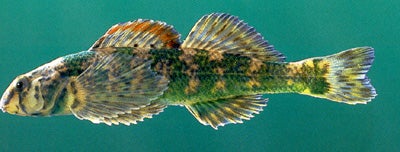HARLEQUIN DARTER
SCIENTIFIC NAME: Etheostoma histrio
CHARACTERISTICS: The harlequin darter is distinguished by two large, tan to dark brown blotches near the caudal fin base and several large, dark spots on the side and ventral surface of the head and body. The gill membranes are broadly connected. On the back are six or seven dark saddles or blotches. The body color of Etheostoma histrio is light brown to tan with seven to 11 dark green or brown vertical bars on the sides of breeding males. The spiny dorsal fin has a red submarginal band. Very prominent dark preorbital and suborbital bars are characteristic for this species. See Gilbert (1887) for original description.
ADULT SIZE: 1.6 to 2.8 in (40 to 70 mm)
DISTRIBUTION: The harlequin darter is found in lower Mississippi River drainages north to the Embarras River in Illinois and in the Gulf slope drainages from the Escambia River west to the Neches and Sabine rivers in Texas. Etheostoma histrio occurs sporadically throughout the Mobile basin except in the Coosa River system. Wall (1968) and Boschung (1992) report single collections in Bear and Yellow creeks, both of which are tributaries to the Tennessee River drainage in Mississippi. Our collections at Cedar Creek in Franklin County and Bumpass Creek in Lauderdale County are the first records of the species in the Alabama section of the drainage. We have recently collected individuals at several locations in the Conecuh River system in south Alabama.
HABITAT AND BIOLOGY: Harlequin darters frequent a variety of habitats. We have collected them in upland streams with gravel and rubble riffles with swift flow and in lowland streams over sand in brush, debris, and log snags with moderate to swift current. We consistently find E. histrio on log snags in swift-flowing, deep waters of the Conecuh River and lower Tallapoosa River while boat electrofishing. Spawning occurs over gravel, rubble, or bedrock in fast current and individuals in breeding color have been observed from mid-March to May. Kuhajda and Warren (1989) report a maximum age of four years in Kentucky and a diet of midge larvae, blackflies, caddisflies, and mayflies. Little else is known about the life history of this colorful darter in Alabama. Five Mile Creek, a tributary of the lower Black Warrior River system in Hale County, and lower Bull Mountain Creek are two places where we have collected the harlequin darter and the similar rock darter together.
ORIGINAL DESCRIPTION: Jordan and Gilbert described the harlequin darter in 1887.
ETYMOLOGY:
Etheostoma means strain mouth, possibly referring to the small mouth.
Histrio means harlequin, a pantomime character in traditional Italian comedy.
The copyrighted information above is from Fishes of Alabama and the Mobile Basin.






